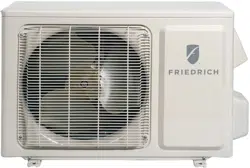Loading ...
Loading ...
Loading ...

60 PB
INSTALLATION
Leak Check, Evacuation, and Charging (Triple Evacuation)
Friedrich requires all installations are Leak Checked and Evacuated in accordance to the “triple evacuation” process. This process pro‑
motes a dry tight refrigeration system before opening the service valves. It recommended that a single port refrigeration manifold and
hoses rated over 800psi be used. Refrigeration hose valves, along with a vacuum pump and micron gauge, must be used to ensure the
system can be vacuumed and held under 500 microns. Check all equipment and hoses for proper usage and leaks before beginning.
1. 1st Nitrogen Pressure Test:
Ensure all refrigeration connections are properly flared, secured, and torqued to their respective settings. Pressurize the
system with nitrogen to 550psi. Soap all connections with an approved refrigerant leak detection solution. The pressure in
the system must hold for one hour respective to the environmental conditions and should not vary less than 540psi. If
pressure can not be adequate held, check integrity of flares and torque specifications. Once pressure is held adequately,
purge the nitrogen charge to system pressure of 5‑10psi. DO NOT RETURN TO ATMOSPHERIC PRESSURE.
2. 1st Vacuum Micron Test:
Connect hoses and vacuum pump to the outdoor unit as shown in Fig.28. Start the vacuum pump and vacuum to 1000
microns. Close the valve to the vacuum pump and check for micron rise for 15 minutes. If microns rise to near
atmospheric pressure, there is a potential leak; follow Section 8.7.A. If microns rise over 5000, the system is very wet and
will require further nitrogen purges.
3. 2nd Nitrogen Break:
Once the system holds below 5000 microns, reconnect the nitrogen tank break the system vacuum with 30‑50psi of
nitrogen. Wait 5 minutes, then purge to 5‑10psi. DO NOT RETURN TO ATMOSPHERIC PRESSURE.
4. 2nd Vacuum Micron Test:
Reconnect vacuum pump and gauge and begin evacuation. Vacuum system to 500 microns. Close vacuum valve
and check for micron rise. Vacuum should hold under 1000 microns. Repeat 8.7.C and 8.7.D until achieved.
5. 3rd Nitrogen Break:
Once the system holds below 1000 microns, reconnect the nitrogen tank break the system vacuum with 30‑50psi of
nitrogen. Wait 5 minutes, then purge to 5‑10psi. DO NOT RETURN TO ATMOSPHERIC PRESSURE.
6. 3rd Final Vacuum Micron Test:
Reconnect vacuum pump and gauge and begin evacuation. Vacuum system to 300 microns. Close vacuum valve
and check for micron rise. Vacuum should hold under 500 microns. Repeat 8.7.C and 8.7.D until achieved. Once held
under 500 microns, the system is considered dry and tight.
7. Charging the system:
Unscrew Service Valve Caps to expose the inner hexagon head. Use an allen‑head spanner or service wrench with
appropriate adapter to release the refrigerant into the system. If the calculated line set length is over 24.9ft, weight
i n the additional charge with an approved refrigerant scale as needed (Fig.28B).
Loading ...
Loading ...
Loading ...
